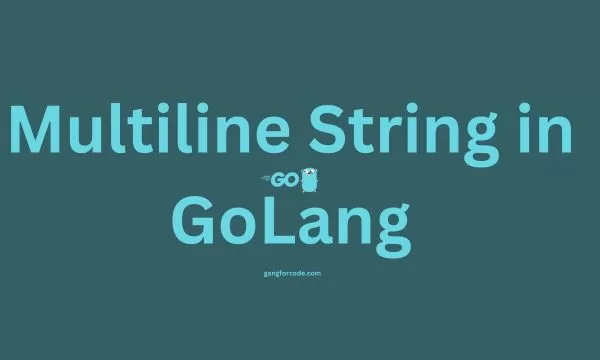Multiline strings are an essential aspect of programming languages, allowing developers to handle large blocks of text efficiently. In Go (or Golang), a statically typed compiled language developed by Google, managing multiline strings is approached uniquely compared to some other languages. This guide will explore how Go handles multiline strings and various effective techniques to work with them.

Table of Contents
In Go, there isn’t a dedicated syntax for multiline strings like in languages such as Python or JavaScript. However, developers can simulate multiline strings using backticks (`) or by using string concatenation.
Using Backticks
One way to create multiline strings in Go is by enclosing the text within backticks. For instance:
package main
import "fmt"
func main() {
multilineString := `
This is a multiline
string in GoLang.
It spans across multiple lines
and maintains the formatting.
`
fmt.Println(multilineString)
}Output

The string can span multiple lines without explicitly using escape characters for line breaks when using backticks. This method preserves the whitespace and formatting within the string. However, it’s essential to note that any indentation at the beginning of each line in the multiline string will be retained.
Using String Concatenation
Another approach to creating multiline strings is by utilizing string concatenation. This involves breaking the string into multiple lines and concatenating them using the + operator. For instance:
package main
import "fmt"
func main() {
multilineString := "This is a multiline\n" +
"string in GoLang.\n" +
"It spans across multiple lines\n" +
"and maintains the formatting.\n"
fmt.Println(multilineString)
}Output

Although this method is explicit and provides more control over the content, it requires manually adding escape characters like \n for line breaks and may be less readable for extensive multiline texts.
Choosing between these methods depends on readability, formatting requirements, and personal preference. Developers might opt for backticks for better readability and maintenance, especially for larger blocks of text with complex formatting.
Manipulating Multiline Strings
Manipulating multiline strings in Go involves searching for substrings, replacing content, or splitting the text. The strings package in Go offers various functions to accomplish these tasks efficiently. For instance:
package main
import (
"fmt"
"strings"
)
func main() {
multilineString := `
This is a multiline
string in GoLang.
It spans across multiple lines
and maintains the formatting.
`
// Example: searching for a substring
if strings.Contains(multilineString, "GoLang") {
fmt.Println("Found 'GoLang' in the multiline string.")
}
// Example: replacing content
replacedString := strings.ReplaceAll(multilineString, "multiline", "multi-line")
fmt.Println(replacedString)
// Example: splitting the text
splitStrings := strings.Split(multilineString, "\n")
fmt.Println(splitStrings)
}Output

The strings package functions such as Contains, ReplaceAll, and Split enable developers to perform operations on multiline strings efficiently.
In conclusion, Go doesn’t have a dedicated syntax for multiline strings, but developers can effectively work with them using backticks or string concatenation. Understanding these approaches and utilizing the strings package for string manipulation can empower Go developers to handle multiline texts proficiently in their applications.
1 thought on “Multiline String in Golang”